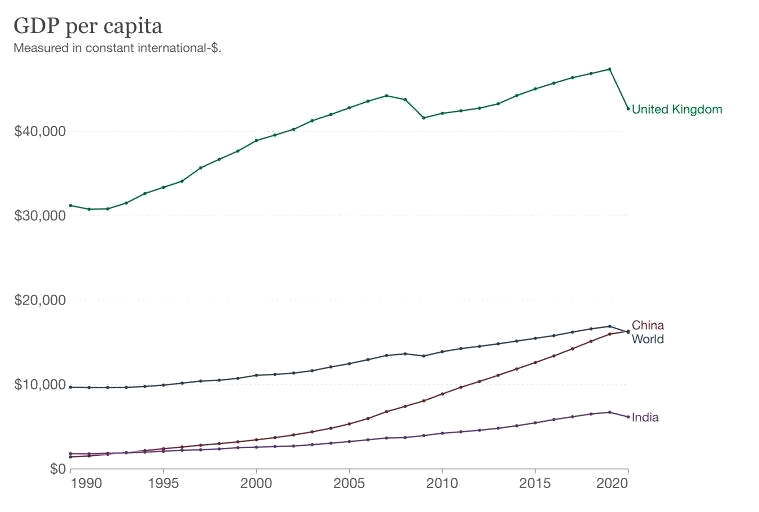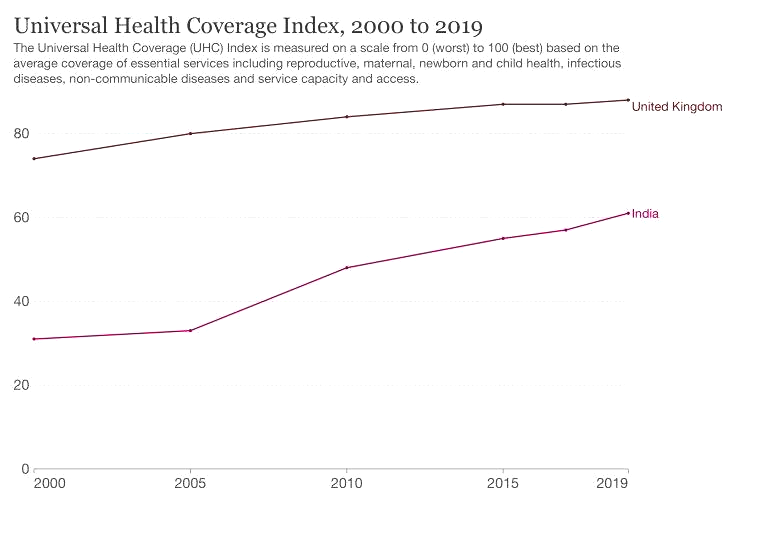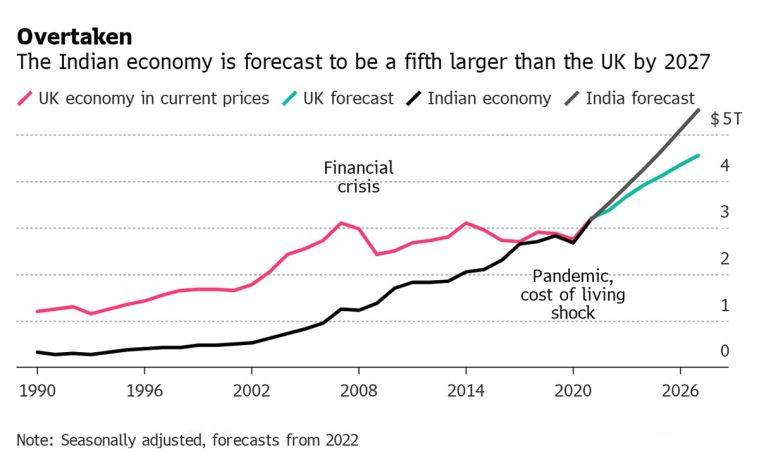India Became the World’s Fifth-largest Economy
For Prelims: Gross domestic product (GDP), Per capita GDP, Universal Health Coverage (UHC) Index, Human Development Index.
For Mains: Growth and Development in Indian Economy.
Why in News?
Recently, India became the world’s fifth largest economy by overtaking the United Kingdom. Now, the United States, China, Japan, and Germany are the only nations with economies larger than India's.
- The real Gross Domestic product (GDP) growth of 6-6.5% in a world full of uncertainties is the new normal and India is set to be the third largest economy by 2029.
What are the Key Highlights of this Achievement?
- New Milestone:
- Moving past one of the biggest economies in the world, especially one that ruled over the Indian sub-continent for two centuries, is a major milestone.
- Size of Economy:
- The size of the Indian economy in ‘nominal’ cash terms in the quarter through March, 2022 was USD 854.7 billion while for UK was USD 816 billion.
- Comparison with United Kingdom:
- Population Size:
- As of 2022, India has a population of 1.41 billion while the UK’s population is 68.5 million.
- GDP Per capita:

- GDP per capita provides a more realistic comparison of income levels because it divides a country’s GDP by the population of that country.
- The per capita income in India remains very low, India is ranked 122 out of 190 countries in terms of per capita income in 2021.
- Poverty:
- The low per capita incomes often point to high levels of poverty.
- At the start of the 19th century, the UK’s share in extreme poverty was considerably higher than India’s.
- However, the relative positions have reversed even though India has made giant strides in curbing poverty.
- Health:

- The Universal Health Coverage (UHC) Index is measured on a scale from 0 (worst) to 100 (best) based on the average coverage of essential services including reproductive, maternal, newborn and child health, infectious diseases, non-communicable diseases and service capacity and access.
- While faster economic growth and the government’s policy focus on healthcare schemes since 2005 have made a distinct improvement for India, there is still a long way to go.
- Human development Index:
- The end goal of higher GDP and faster economic growth is to have better human development parameters.
- According to HDI (2019), the UK score is 0.932 and India’s score is 0.645 which is comparatively far behind the UK.
- Despite its secular improvement, India might still take a decade to be where the UK was in 1980.
- Present outlook:
- The dramatic shift has been driven by India's rapid economic growth over the past 25 years as well as downslides in the value of the pound over the last 12 months.
- The right policy perspective and realignment in global geopolitics could further, also lead to an upward revision in its estimates for India.
- The dramatic shift has been driven by India's rapid economic growth over the past 25 years as well as downslides in the value of the pound over the last 12 months.
- Population Size:
What are the Issues Related to Indian Economy?
- Slowing Exports and Rising Imports:
- The slowing growth of the manufacturing sector at 4.8% is an area of worry.
- Also, imports being higher than exports is a matter of concern.
- The slowing growth of the manufacturing sector at 4.8% is an area of worry.
- Unpredictable Weather:
- There is an uneven monsoon that is likely to weigh upon agriculture growth and rural demand.
- Rising Inflation:
- There has been continuous rise in inflation about 6% for seven straight months.
- The Indian economy faces headwinds from higher energy and commodity prices that are likely to weigh on consumer demand and companies' investment plans.
- There has been continuous rise in inflation about 6% for seven straight months.
What Is Gross Domestic Product (GDP)?
- Gross domestic product (GDP) is the total monetary or market value of all the finished goods and services produced within a country’s borders in a specific time period.
- As a broad measure of overall domestic production, it functions as a comprehensive scorecard of a given country’s economic health.
UPSC Civil Services Examination Previous Year Question (PYQ)
Prelims
Q. With reference to Indian economy, consider the following statements: (2015)
- The rate of growth of Real Gross Domestic Product has steadily increased in the last decade.
- The Gross Domestic Product at market prices (in rupees) has steadily increased in the last decade.
Which of the statements given above is/are correct?
(a) 1 only
(b) 2 only
(c) Both 1 and 2
(d) Neither 1 nor 2
Ans: (b)
- Gross Domestic Product (GDP) is the monetary value of all the final goods and services produced within a country’s borders in a specific time period, generally 1 year. It is a broad measurement of a nation’s overall economic activity.
- Real Gross Domestic Product is an inflation-adjusted measure that reflects the value of all goods and services produced by an economy in a given year, expressed in base-year prices.
- The rate of growth of real GDP has not steadily increased in the last decade. It has fluctuated due to various international and domestic economic pressures. Hence, statement 1 is not correct.
- The GDP at market prices of India has steadily increased in the last decade from around 900 billion USD in 2005 to 2.1 trillion USD in 2015. As of 2020, India’s GDP is 2.63 trillion USD. Hence, statement 2 is correct. Therefore, option (b) is the correct answer.
